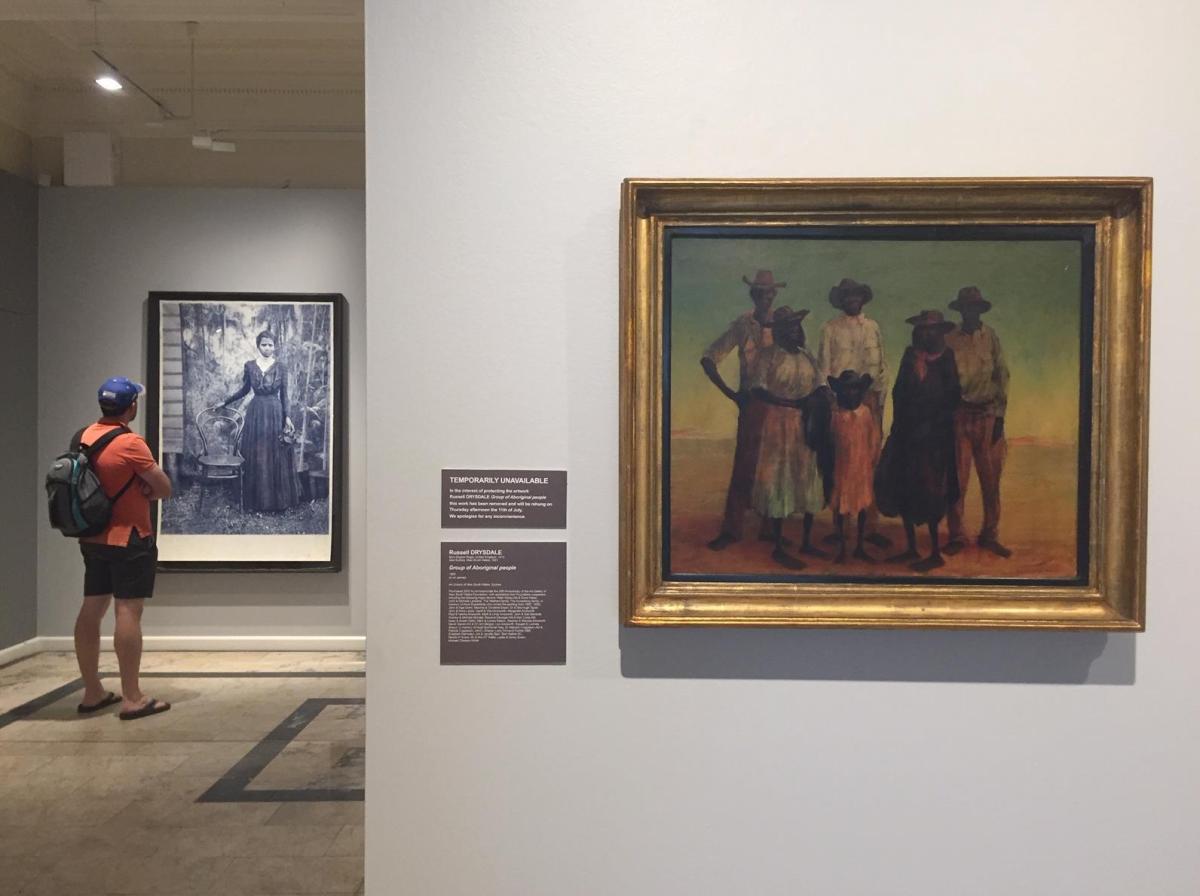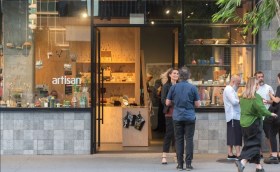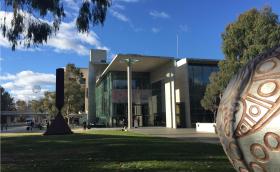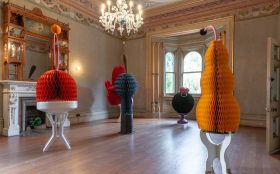Installation view Queen’s Land Blak Portraiture, Cairns Art Gallery 2019; L Danie Mellor, R Russell Drysdale; Photo ArtsHub
Cairns Art Gallery’s current exhibition, Queen’s Land Blak Portraiture – Late 19th century to the present has been in gestation for three years following Director Andrea May Churcher’s visit to South Africa for a conference on presenting contemporary identity, which resulted in the exhibition Fashioning Black Identity – Africa and the African Diaspora earlier this year.
Like that show, which broached a thorny topic of pictured identity with a very considered lens, this exhibition on Blak Portraiture has been needed for a long time.
While it goes without saying, the artworks in this show are very familiar to many of us, together here in this context – and at volume – they broach the conversation at a level twhich has not been had to date.
The curatorial concept for this project has been developed by Churcher, while senior curator Julietta Park, has worked with Consultant Curator Djon Mundine OAM, Artistic Director of CIAF, Janina Harding and Michael Aird, Research Fellow, School of Social Science, University of Queensland, to realise the exhibition.
The success of this exhibition is in its cluster of works, and in its sight lines across the gallery that continue and extend the narratives, and in doing so start to build a more holistic picture of the complexity that sits around Blak Portraiture.
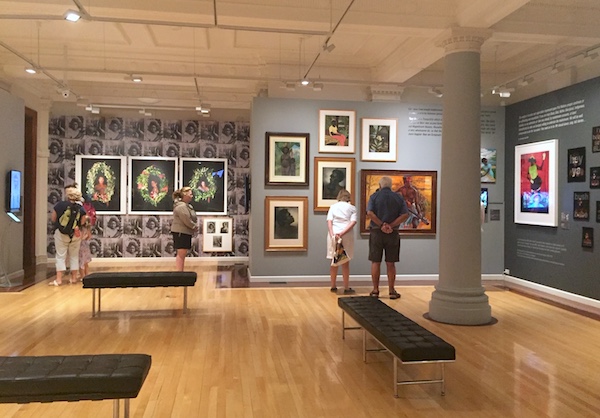
Installation view Queen’s Land Blak Portraiture, Cairns Art Gallery 2019; Photo ArtsHub
Consider this line up: Megan Cope’s video The Blaktism (2014) where the artist is ritualistically made more “black”, Archie Moore’s video Blood Fraction (2015) where similarly a self-portrait slowly adjusts to arrive at a blue-eyed “whiter” version of himself, and that archival photograph by Alfred Atkins, Portrait of a young woman from Caldwell, which is accompanied by the hand written-note, “she was fair as fair as they could be.”
Text is important to this exhibition. The words of the artist are punched out as wall didactics – historical quotes have been collected and even the deliberate choice of works that use text help add layers to this complex narrative.Archival images are also used as a wallpaper to present the contemporary photographs, playing off the misnomer that historically Aboriginal people were covered under the Flora and Fauna Act.

Installation view image of Shannon Brett’s “Exotic Weeds”Queen’s Land Blak Portraiture, Cairns Art Gallery 2019; Photo ArtsHub
In an adjacent cluster of works, similarly the curators look at the colonial perception of an Aborigine as the “noble savage”, pairing a group of Ray Cook’s paintings with Tracey Moffatt’s Other (2009), and Tony Albert’s kitsch velvet paintings that overlay pointed text over remnants of a mid-20th century fashion of the Aborigine as “exotic” and saleable tourist decor art.
This series is updated with the wall-based work ALIEN (2019), a new piece for the exhibition, and one that ratchets that term into 21st century nomenclature.
As a green card holder for a period of time, I was classified a “resident alien” in the US. Albert plays on this same kind of exclusive classification that has really shifted little since those early Flora Fauna works across the room.
These transitions to a very contemporary reading of ‘other’ – that is the pairing of these long-seen historical images from our museum and gallery collections with familiar images of “push back” by contemporary Aboriginal and Torres Strait Islander artists rewriting that identity on their terms – are what make this exhibition so incredibly successful and accessible as a topic for discussion.
Completing that lower gallery journey, viewers are faced with Tony Albert’s brother series (2013), where young men are literally targeted for their skin colour, with Vernon Ah Kee’s abutted series, Whitefellanormalblackfellame (2004) with This man is…This woman is… (2003) with altering captions for the same portrait.

Installation detail view Vernon Ah Kee’s work in Queen’s Land Blak Portraiture, Cairns Art Gallery 2019; Photo ArtsHub
Both play off the “mugshot”; assigning an almost criminal activity to skin colour, and questioning institutional and societal injustice.
Fellow artist Julie Gogh said of Ah Kee’s work: ‘This is history being made. We recast ourselves in our own image.’
It sounds like an exhaustive and somewhat confused eddy of artworks, but it is perhaps the clearest presentation of the multifarious layers that we need to get our head around to start to unpack Blak identity as we have collectively pictured it – and accepted it as historical record.
As the viewer finds their way up the stairs of this decided colonial building with its imposing staircase, that frisson, or tension is palpable. One can’t help but be excited by the overlaying of histories, and the kind of usurping of that self-appointed colonial power by these artists.
In the upper galleries there is an even stronger sense of ricochet in time – that push and pull of memory and record.
Russell Drysdale’s signature painting Group of Aboriginal People (1953) is paired with photographs of family gatherings – two from c. 1870 and another from c. 1970. The implication is, what has really changed? We are still caught in the ethnographic lens.
Backing these are works by Danie Mellor and Vernon Ah Kee, who both create their own representations of their ancestors.
Mellor’s A gaze still dark (a black portrait of intimacy) (2019) (pictured top) is a new work made for the exhibition and pictures his grandmother in colonial dress.
These works sit beautifully in conversation with a suite of self-portraits by Fiona Foley that respond to an archival photograph taken by the Bain studio in c.1900 of a young woman from Fraser Island. That image was then painted by colonialist Oscar Fristrom, Aboriginal Woman (1902).
Dr Sandra Phillips writes of these works: ‘Vernon [as well as Mellor and Foley] is essentially reclaiming family from those archives, drawing the family in his own hand.’ It is about an unbroken lineage contrary to the concept of terra nullius.
It is not all archive, family, gloss and reclaimed self-pride. This exhibition has its dark histories as well.
Heather Wunjarra Koowootha offers a very raw narrative of the implications of life within the missionaries, as does Michael Cook and Tracey Moffatt, with works that speak of a stolen generation. They are again presented alongside archive photographs demonstrating two-sides of the story.
Michael Riley also presents a pretty hardcore collection of videos and works on paper in a side room that speak to the implications of trauma.

Installation view Michael Riley and photographic installation Narelle Nicol, in Queen’s Land Blak Portraiture, Cairns Art Gallery 2019; Photo ArtsHub
You can feel the activism tone rising in these upper galleries – it is like one has moved through all this history and yet voices are still not being heard. This is addressed in the last gallery that visitors encounter, with photographs by Ricky Maynard and Christian Thompson, protest images by photographers such as Juno Gemes and others, and Fiona Foley’s powerful HHH (2004) series of hooded portraits that play off the vernacular of fear and demonisation of the Ku Klux Klan.

Installation view protest art and Ricky Maynard (L) in Queen’s Land Blak Portraiture, Cairns Art Gallery 2019; Photo ArtsHub

Installation detail view Fiona Foley’s HHH series in Queen’s Land Blak Portraiture, Cairns Art Gallery 2019; Photo ArtsHub
This exhibition is dense – both in volume and message. And while is could feel a little congested at times, this is a congested and somewhat unsettling dialogue.
It is a wallop to digest, and while the visitor is not going to take in all the nuances – all the stories – they will start to arrive at a more accurate truth than what past exhibitions have offered.
I truly hope this exhibition finds the funding to tour. It is an exhibition that all Australians not only should – but NEED – to see. The gallery is in the process of creating a VR online experience to walk through the exhibition.
Rating ★★★★★
Queen’s Land Blak Portraiture – Late 19th century to the present
Cairns Art Gallery
17 May – 11 August
www.cairnsartgallery.com.au
The writer travelled to Cairns as a guest of CIAF Visiting Journalist Program

